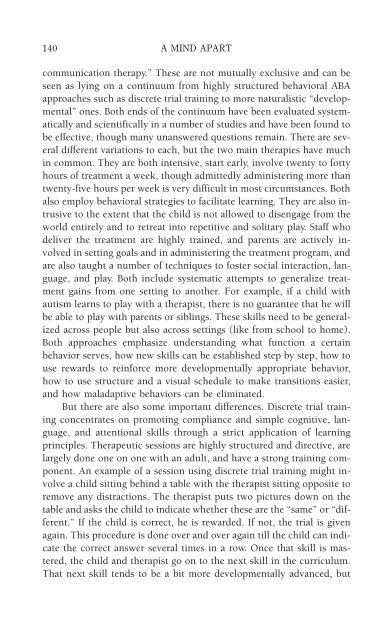978-1572305441
autism
autism
You also want an ePaper? Increase the reach of your titles
YUMPU automatically turns print PDFs into web optimized ePapers that Google loves.
140 A MIND APART<br />
communication therapy.” These are not mutually exclusive and can be<br />
seen as lying on a continuum from highly structured behavioral ABA<br />
approaches such as discrete trial training to more naturalistic “developmental”<br />
ones. Both ends of the continuum have been evaluated systematically<br />
and scientifically in a number of studies and have been found to<br />
be effective, though many unanswered questions remain. There are several<br />
different variations to each, but the two main therapies have much<br />
in common. They are both intensive, start early, involve twenty to forty<br />
hours of treatment a week, though admittedly administering more than<br />
twenty-five hours per week is very difficult in most circumstances. Both<br />
also employ behavioral strategies to facilitate learning. They are also intrusive<br />
to the extent that the child is not allowed to disengage from the<br />
world entirely and to retreat into repetitive and solitary play. Staff who<br />
deliver the treatment are highly trained, and parents are actively involved<br />
in setting goals and in administering the treatment program, and<br />
are also taught a number of techniques to foster social interaction, language,<br />
and play. Both include systematic attempts to generalize treatment<br />
gains from one setting to another. For example, if a child with<br />
autism learns to play with a therapist, there is no guarantee that he will<br />
be able to play with parents or siblings. These skills need to be generalized<br />
across people but also across settings (like from school to home).<br />
Both approaches emphasize understanding what function a certain<br />
behavior serves, how new skills can be established step by step, how to<br />
use rewards to reinforce more developmentally appropriate behavior,<br />
how to use structure and a visual schedule to make transitions easier,<br />
and how maladaptive behaviors can be eliminated.<br />
But there are also some important differences. Discrete trial training<br />
concentrates on promoting compliance and simple cognitive, language,<br />
and attentional skills through a strict application of learning<br />
principles. Therapeutic sessions are highly structured and directive, are<br />
largely done one on one with an adult, and have a strong training component.<br />
An example of a session using discrete trial training might involve<br />
a child sitting behind a table with the therapist sitting opposite to<br />
remove any distractions. The therapist puts two pictures down on the<br />
table and asks the child to indicate whether these are the “same” or “different.”<br />
If the child is correct, he is rewarded. If not, the trial is given<br />
again. This procedure is done over and over again till the child can indicate<br />
the correct answer several times in a row. Once that skill is mastered,<br />
the child and therapist go on to the next skill in the curriculum.<br />
That next skill tends to be a bit more developmentally advanced, but



